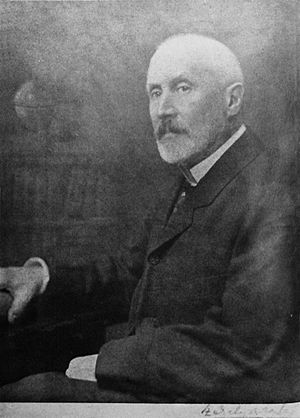Loránd Eötvös facts for kids
Quick facts for kids
Loránd Eötvös
|
|
|---|---|

Eötvös in 1912
|
|
| Born | 27 July 1848 Buda, Kingdom of Hungary
|
| Died | 8 April 1919 (aged 70) Budapest, Hungarian Soviet Republic
|
| Nationality | Hungarian |
| Alma mater | University of Heidelberg |
| Known for | Eötvös effect Eötvös experiment Eötvös number Eötvös rule |
| Spouse(s) | Gizella Horvát |
| Children | Jolán Rolanda Ilona |
| Parent(s) | József Eötvös Agnes Rosty de Barkócz |
| Scientific career | |
| Fields | Physics |
| Institutions | University of Budapest |
| Doctoral advisor | Hermann Helmholtz |
Loránd Eötvös (born July 27, 1848 – died April 8, 1919) was a famous Hungarian physicist. He is best known for his important work on gravity and surface tension. He also invented a special tool called the torsion pendulum.
Many things are named after him. These include the Eötvös Loránd University in Hungary and the Eötvös crater on the Moon. An asteroid, 12301 Eötvös, and a mineral, lorándite, also carry his name. There is even a mountain peak in the Dolomites called Cime Eotvos.
Contents
About Loránd Eötvös's Life
Loránd Eötvös was born in 1848. This was the same year as the Hungarian revolution. His father was József Eötvös, a well-known poet and politician. József Eötvös was a government minister at the time. He was very important in Hungarian thinking and politics.
Loránd's mother was Agnes Rosty de Barkócz. She came from a noble Hungarian family. His uncle, Pál Rosty de Barkócz, was a photographer and explorer. He traveled to places like Texas and Mexico.
His Education and Career
Loránd Eötvös first started studying law. But he soon changed his mind and decided to study physics. He went to study in other countries, in cities like Heidelberg and Königsberg.
After he finished his studies, he became a university professor. He taught in Budapest, Hungary. For nearly 50 years, he was a leader in Hungarian science. He became famous around the world. This was first for his new ideas about how liquids behave. Later, he was known for his careful experiments with gravity.
His Work on Gravity
Eötvös is remembered for his experiments on gravity. He studied how mass and gravity are connected. This is called the "weak equivalence principle." His experiments showed that gravity affects all objects in the same way.
Albert Einstein mentioned Eötvös's experiment in his 1916 paper. This paper was about the theory of general relativity. Measuring gravity's changes on Earth is important for geophysics. This helps find things like oil underground. A unit for measuring gravity's changes is called the eotvos. It is named in his honor.
From 1886 until he died, Loránd Eötvös taught at the University of Budapest. In 1950, the university was renamed after him. He is buried in the Kerepesi Cemetery in Budapest.
The Eötvös Torsion Balance
Loránd Eötvös designed a special tool called the Eötvös pendulum. It is a type of torsion balance. This tool is very sensitive. It can measure the density of rocks deep underground.
The Eötvös pendulum does more than just measure the direction of gravity. It also measures how gravity changes across the Earth's surface. This helps scientists understand how masses are spread out in the Earth's crust.
How the Torsion Balance Helps
The Eötvös torsion balance is an important tool for geodesy and geophysics. It helps study the Earth's physical properties. It is used to explore mines. It also helps find valuable minerals like oil, coal, and metal ores.
Eötvös never patented his pendulum. But after he showed how accurate it was, many countries wanted one. The Eötvös pendulum helped discover some of the richest oil fields in the United States.
This tool also helped prove that inertial mass and gravitational mass are equal. This idea was later used by Albert Einstein. It was a key part of his theory of general relativity.
Honors and Recognition
Hungary has honored Loránd Eötvös many times.
- On July 1, 1932, a postage stamp was issued with his picture.
- Another stamp was issued on July 27, 1948. This was to celebrate 100 years since his birth.
- Hungary issued a third postage stamp on January 31, 1991.
See also
 In Spanish: Loránd Eötvös para niños
In Spanish: Loránd Eötvös para niños
- Eotvos, a unit of gravitational gradient
- List of geophysicists
- Lorándite, a mineral named after Loránd Eötvös

